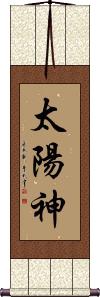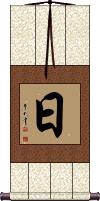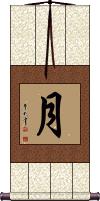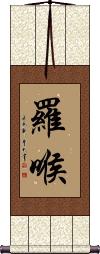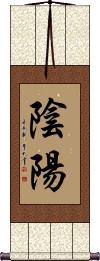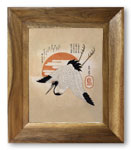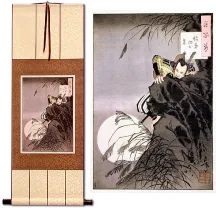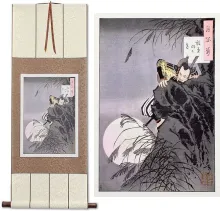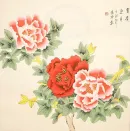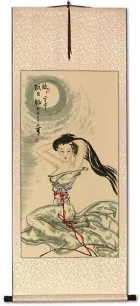Many custom options...
And formats...

The name Sun and Moon in Chinese / Japanese...
Buy a Sun and Moon calligraphy wall scroll here!
Personalize your custom “Sun and Moon” project by clicking the button next to your favorite “Sun and Moon” title below...
Apollo
太陽神 means “Sun God” in Chinese, Japanese, and Korean.
It's used in Chinese to mean the Greek God Apollo. This can also be used in Chinese to refer to Nasa's Apollo missions to the moon.
This is how to write “day” in Chinese, Japanese, and Korean Hanja.
This can also mean “Sun,” the star in the middle of the Solar system in which we live. In Japanese, it can also mean “sunshine” or even “Sunday.”
When writing the date in modern Chinese and Japanese, putting a number in front of this character indicates the day of the month. Of course, you need to indicate the month too... The month is expressed with a number followed by the character for the moon. So “three moons ten suns” would be “March 10th” or “3/10.”
Note: This is also the first character for the proper name of Japan. Remember that Japan is “The land of the rising sun”? Well, the first character for Japan means “sun” and the second means “origin” so you get the real meaning now. Sometimes, in China, this sun character can be a short name for Japan or a suffix for something of or from Japan.
Moon
月 is how to write the title for “moon” in Chinese, Korean Hanja, and Japanese Kanji.
月 is also used to refer to the month. This is because China traditionally uses a lunar calendar, so saying “next moon” is the same as saying “next month” etc.
In modern Chinese and Japanese and old Korean, the character for a number is put in front of this moon character to represent western months. So “one moon” is January “two moons” is February etc.
If you are wondering, in the east Asian way to write dates, the character for “sun” or “day” is used with a number in front of it to express the day of the month. So “ten moons, one sun” becomes “October 1st” or “10/1” (this date happens to be Chinese National Day - The equivalent of Independence Day in the USA, Canada Day, or the Queen's Birthday).
In Japanese, 月 can be a surname that romanizes as Tsuki, Tsukizaki, or Takagetsu.
Rago
This is a Japanese personal name, Rago.
The meaning can be the intersection of the Moon's orbit with the ecliptic in Vedic astronomy (from Sanskrit Rāhu).
In Buddhist context, this can be, “the demon who is supposed to seize the sun and moon and thus cause eclipses.”
This is a variant of the Chinese 羅睺. It can also be written 羅護 or 羅虎. If you need the more ancient Chinese version, just let me know.
The Sun, Moon, and Stars
日月星辰 is a title that encompasses all of the heavenly bodies or celestial bodies.
Namely, this includes the Sun, Moon, and Stars of our universe.
Sun Moon Stars
Yin Yang
陰陽 literally means yin and yang in written form (versus the common yin-yang symbol). The first character has the element of the moon, while the second character has the element of the sun so that you can see, even in written form, they suggest the balance of opposites (of night and day). You could also translate this title as “sun and moon.”
Note: This title is often misspelled as Ying Yang instead of Yin Yang.
See Also: Taoism
This in-stock artwork might be what you are looking for, and ships right away...
Gallery Price: $108.00
Your Price: $59.88
Gallery Price: $108.00
Your Price: $59.88
Gallery Price: $220.00
Your Price: $79.88
Gallery Price: $220.00
Your Price: $79.88
Gallery Price: $220.00
Your Price: $79.88
Gallery Price: $126.00
Your Price: $69.88
Gallery Price: $61.00
Your Price: $33.88
Gallery Price: $61.00
Your Price: $33.88
Gallery Price: $61.00
Your Price: $33.88
Gallery Price: $61.00
Your Price: $33.88
Gallery Price: $200.00
Your Price: $88.88
Gallery Price: $108.00
Your Price: $59.88
Not the results for sun and moon that you were looking for?
Below are some entries from our dictionary that may match your sun and moon search...
| Characters If shown, 2nd row is Simp. Chinese |
Pronunciation Romanization |
Simple Dictionary Definition |
陰陽 阴阳 see styles |
yīn yáng yin1 yang2 yin yang inyou(p); onmyou; onyou / inyo(p); onmyo; onyo いんよう(P); おんみょう; おんよう |
More info & calligraphy: Yin Yangcosmic dual forces; yin and yang; sun and moon, etc.; (place-name) In'you yin and yang |
日月星辰 see styles |
jitsugetsuseishin; nichigetsuseishin / jitsugetsuseshin; nichigetsuseshin じつげつせいしん; にちげつせいしん |
More info & calligraphy: The Sun, Moon, and Stars |
曜 see styles |
yào yao4 yao you / yo よう |
bright; glorious; one of the seven planets of premodern astronomy (female given name) Yō Brilliant, shining. 七曜 The sun, moon, and five planets. 曜宿 These seven and the constellations, the celestial orbs. |
七曜 see styles |
qī yào qi1 yao4 ch`i yao chi yao shichiyou / shichiyo しちよう |
the seven planets of premodern astronomy (the Sun, the Moon, Mercury, Venus, Mars, Jupiter, and Saturn) (1) {astron} the seven luminaries (sun, moon, Mercury, Venus, Mars, Jupiter and Saturn); (2) the seven days of the week The seven brilliant ones — the sun and moon, together with the five planets which are connected with fire, water, wood, metal, and earth. Their essence shines in the sky, but their spirits are over men as judges of their good and evil, and as rulers over good and evil fortune. The following list shows their names in Chinese and Sanskrit: Sun 日, 太陽; aditya 阿彌底耶 Moon月, 太陰; soma 蘇摩 Mars火星, 勢惑勞; aṅgāraka 盎哦囉迦 Mercury水星, 辰星; budha 部陀 Jupiter木星, 歳星; bṛhaspati 勿哩訶娑跛底 Venus金星, 太白; śukra 戌羯羅 Saturn土星, 鎭星; śanaiścara 賖乃以室折羅. |
七難 七难 see styles |
qīn án qin1 an2 ch`in an chin an shichinan しちなん |
(1) {Buddh} the Seven Misfortunes; (2) great number of faults or defects The seven calamities in the仁王經, 受持品 during which that sūtra should be recited: sun and moon losing their order (eclipses), conste11ations, irregular, fire, flood, wind-storms, drought, brigands Another set is — pestilence, invasion, rebe11ion, unlucky stars, eclipses, too early monsoon, too late monsoon. Another is — fire, flood, rakṣas, misrule, evil spirits, cangue and prison, and robbers. |
三光 see styles |
sān guāng san1 guang1 san kuang sankou / sanko さんこう |
the sun, the moon, and the stars (1) (poetic term) the Sun, the Moon and the stars; (2) {hanaf} three 20-point cards (high-scoring meld); (personal name) Miteru (三光天) Sun, moon, and stars. Also, in the second dhyāna of the form-world there are the two deva regions 少光天, 無量光天, and 光音天q.v. Also 觀音 Avalokiteśvara is styled 日天子sun-prince, or divine son of the sun, 大勢至 Mahāsthāmaprapta is styled 月天子 divine son of the moon, and 虛空藏菩薩 the bodhisattva of the empyrean, is styled 明星天子 divine son of the bright stars. |
九曜 see styles |
jiǔ yào jiu3 yao4 chiu yao kuyou / kuyo くよう |
(surname) Kuyou 九執 q.v. Navagraha. The nine luminaries: 日 Āditya, the sun; 月 Sōma, the moon; the five planets, i.e. 火星 Aṅgāraka, Mars; 水 Budha, Mercury; 木 Bṛhaspati, Jupiter; 金 Sukra, Venus; and 土 Śanaiścara, Saturn; also 羅睺 Rāhu, the spirit that causes eclipses; and 計都 Ketu, a comet. Each is associated with a region of the sky and also with a bodhisattva, etc., e.g. the sun with Guanyin, Venus with Amitābha, etc. |
五夢 五梦 see styles |
wǔ mèng wu3 meng4 wu meng itsumu いつむ |
(female given name) Itsumu The five bad dreams of King Ajātaśatru on the night that Buddha entered nirvana— as the moon sank the sun arose from the earth. the stars fell like rain, seven comets appeared, and a great conflagration filling the sky fell on the earth. |
五翳 see styles |
wǔ yì wu3 yi4 wu i go ei |
The five films, or interceptors of the light of sun and moon— smoke, cloud dust, fog, and the hands of asuras. |
入る see styles |
iru いる |
(v5r,vi) (1) (mainly used in fixed expressions and literary language) (See 入る・はいる・1) to enter; to go in; to get in; to come in; (v5r,vi) (2) to set (of the sun or moon); to sink; to go down; (v5r,vi) (3) to attain (nirvana, enlightenment, etc.); to achieve; to reach (e.g. a climax); (suf,v5r) (4) (after -masu stem of verb) (See 感じ入る,聞き入る) to do fully; to do intently; to do sincerely; to do deeply; to feel keenly; (suf,v5r) (5) (after -masu stem of verb) (See 寝入る・1,絶え入る) to (reach a state) completely; (place-name) Iru |
四翳 see styles |
sì yì si4 yi4 ssu i shiei |
The four films, or things that becloud, i. e. rain-clouds; dust-storms; smoke; and asuras, i. e. eclipses of sun and moon; emblematic of desire, hate, ignorance, and pride; cf. 四結. |
大刧 大劫 see styles |
dà jié da4 jie2 ta chieh daikō |
mahākalpa. The great kalpa, from the beginning of a universe till it is destroyed and another begins in its place. It has four kalpas or periods known as vivarta 成刧 the creation period; vivarta‐siddha 住刧 the appearance of sun and moon, i.e. light, and the period of life, human and general; saṃvarta 壤刧 or 滅刧 destruction first by fire, then water, then fire, then deluge, then a great wind, i.e. water during seven small kalpas, fire during 56 and wind one, in all 64; saṃvartatthāhi 増滅刧 total destruction gradually reaching the void. A great kalpa is calculated as eighty small kalpas and to last 1,347,000,000 years. |
天女 see styles |
tiān nǚ tian1 nv3 t`ien nü tien nü tennyo てんにょ |
(1) heavenly nymph; celestial maiden; (2) beautiful and kind woman; (female given name) Tennyo devakanyā; apsaras; goddesses in general; attendants on the regents of the sun and moon; wives of Gandharvas, the division of the sexes is maintained throughout the devalokas 六 天. |
成劫 see styles |
chéng jié cheng2 jie2 ch`eng chieh cheng chieh joukou; jougou / joko; jogo じょうこう; じょうごう |
{Buddh} (See 四劫) the kalpa of formation (the first aeon of the universe) vivarta kalpa, one of the four kalpas, consisting of twenty small kalpas during which worlds and the beings on them are formed. The others are: 住劫 vivarta-siddha kalpa, kalpa of abiding, or existence, sun and moon rise, sexes are differentiated, heroes arise, four castes are formed, social life evolves. 壞劫saṃvarta kalpa, that of destruction, consisting of sixty-four small kalpas when fire, water, and wind destroy everything except the fourth dhyāna. 空劫 saṃvarta-siddha kalpa, i.e. of annihilation. v. 劫波. |
日月 see styles |
rì yuè ri4 yue4 jih yüeh jitsugetsu; nichigetsu じつげつ; にちげつ |
the sun and moon; day and month; every day and every month; season; life and livelihood (1) sun and moon; (2) time; days and months; years; (3) (にちげつ only) Sunday and Monday; (female given name) Hizuki sun and moon |
星宿 see styles |
xīng xiù xing1 xiu4 hsing hsiu shōshuku ほとほりぼし |
constellation (arch., now 星座); one of the 28 constellations of traditional Chinese astronomy and astrology; motion of stars since one's birth (predetermining one's fate in astrology) (1) (astron) constellation; (2) (astron) (archaism) mansion (any of the Chinese constellations used to divide the ecliptic into 28 positions); (3) (astron) Chinese "star" constellation (one of the 28 mansions) The twenty-eight Chinese constellations 二十八宿; also the twenty-eight nakṣatras; the 十二宮 twelve rāṣi, or zodiacal mansions; and the 七曜 seven mobile stars: sun, moon, and five graha or planets; all which are used as auguries in 星占法 astrology. A list giving Sanskrit and Chinese names, etc・, is given in 佛學大辭典, pp. 1579-1 580. |
月日 see styles |
tsukihi つきひ |
(1) time; years; days; (one's) life; (2) (See 日月・1) the Moon and the Sun |
烏兎 see styles |
uto うと |
(1) (abbreviation) (See 金烏玉兎) sun and moon; (2) time; the years; the months |
羅睺 罗睺 see styles |
luó hóu luo2 hou2 lo hou rago; ragou / rago; rago らご; らごう |
the intersection of the Moon's orbit with the ecliptic in Vedic astronomy (Sanskrit rahu) Rago; mythological celestial body and-or evil spirit (asura) said to cause eclipses Rāhu, also羅護; 羅虎; "the demon who is supposed to seize the sun and moon and thus cause eclipses." M.W. |
迦葉 迦叶 see styles |
jiā shě jia1 she3 chia she kashou / kasho かしょう |
(person) Kasyapa (Hindu sage); Kashou (迦葉波) kāśyapa, 迦攝 (迦攝波) inter alia 'a class of divine beings similar to or equal to prajāpati'; the father 'of gods, demons, men, fish, reptiles, and all animals'; also 'a constellation'. M.W. It is intp. as 'drinking light', i.e. swallowing sun and moon, but without apparent justification. (1) One of the seven or ten ancient Indian sages. (2) Name of a tribe or race. (3) Kāśyapa Buddha, the third of the five buddhas of the present kalpa, the sixth of the seven ancient buddhas. (4) Mahākāśyapa, a brahman of Magadha, who became one of the principal disciples of Śākyamuni, and after his death became leader of the disciples, 'convoked and directed the first synod, whence his title Ārya Sthavira (上坐, lit. chairman) is derived.' Eitel. He is accounted the chief of the ascetics before the enlightenment; the first compiler of the canon and the first patriarch. (5) There were five Kāśyapas, disciples of the Buddha, Mahā-Kāśyapa, Uruvilā-Kāśyapa, Gayā-Kāśyapa, Nadī-Kāśyapa, and Daśabala-Kāśyapa; the second, third, and fourth are said to have been brothers. (6) A bodhisattva, whose name heads a chapter in the Nirvana Sutra. (7) 迦葉摩騰 Kāśyapa-Mātaṅga, the monk who with Gobharana, or Dharmarakṣa, i.e. Zhu Falan 竺法蘭, according to Buddhist statements, brought images and scriptures to China with the commissioners sent by Mingdi, arriving in Luoyang A.D. 67. |
龍珠 龙珠 see styles |
lóng zhū long2 zhu1 lung chu ryuuju / ryuju りゅうじゅ |
(personal name) Ryūju Dragon-pearl; pearl below the dragon's jaws; the sun or moon associated with the dragon and spring. |
七曜星 see styles |
shichiyousei / shichiyose しちようせい |
(1) {astron} (See 北斗七星) the Big Dipper (asterism); the Plough; the Plow; (2) {astron} (See 七曜・1) the seven luminaries (sun, moon, Mercury, Venus, Mars, Jupiter and Saturn) |
五類天 五类天 see styles |
wǔ lèi tiān wu3 lei4 tian1 wu lei t`ien wu lei tien gorui ten |
The five kinds of devas: (1) 上界天 in the upper realms of form and non-form; (2) 虛空天 in the sky, i. e. four of the six devas of the desire-realm; (3) 地居天 on the earth, i. e. the other two of the six devas, on Sumeru; (4) 遊虛天空 wandering devas of the sky, e. g. sun, moon, starvas, (5) 地下天 under-world devas, e. g. nāgas, asuras, māras, etc. Of. 五大明王. |
十二天 see styles |
shí èr tiān shi2 er4 tian1 shih erh t`ien shih erh tien juuniten / juniten じゅうにてん |
twelve devas (esp. of the Shingon sect); (place-name) Jūniten The twelve devas (especially of the Shingon sect): Brahmā; the deva of earth; of the moon; of the sun; Indra; of fire; Yama; of the rakṣas (or demons); of water; of wind; Vaiśramaṇa (wealth); and Maheśvara (Śiva). Also 十二大天衆. |
四明山 see styles |
sì míng shān si4 ming2 shan1 ssu ming shan Shimyō san |
A mountain range in Ningbo prefecture where the 四明 are clearly seen, i. e. sun, moon, stars, and constellations. 知禮 Zhili of the Sung dynasty is known as the 四明尊者 honoured one of Siming and his school as the 四明家 Siming school in the direct line of Tiantai. In Japan Mt. Hiei 比叡山 is known by this title, through Dengyo 傳教 the founder of the Japanese Tiantai School. |
摩利支 see styles |
mó lì zhī mo2 li4 zhi1 mo li chih marishi まりし |
{Buddh} Marici (or 摩梨支, or 摩里支); 末利支 Marīci. Rays of light, the sun's rays, said to go before the sun; mirage; also intp. as a wreath. A goddess, independent and sovereign, protectress against all violence and peril. 'In Brahmanic mythology, the personification of light, offspring of Brahmā, parent of Sūrya.' 'Among Chinese Buddhists Maritchi is represented as a female with eight arms, two of which are holding aloft emblems of sun and moon, and worshipped as goddess of light and as the guardian of all nations, whom she protects from the fury of war. She is addressed as 天后 queen of heaven, or as 斗姥 lit. mother of the Southern measure (μλρστζ Sagittarī), and identified with Tchundi' and 'with Mahēśvarī, the wife of Maheśvara, and has therefore the attribute Mātrikā', mother of Buddhas. Eitel. Taoists address her as Queen of Heaven. |
日月眼 see styles |
rì yuè yǎn ri4 yue4 yan3 jih yüeh yen jitsugetsu gan |
eyes of the sun and moon |
月面佛 see styles |
yuè miàn fó yue4 mian4 fo2 yüeh mien fo Gachimen Butsu |
The 'moon-face Buddha', whose life is only a day and a night, in contrast with the sun-face Buddha whose life is 1, 800 years. |
金剛界 金刚界 see styles |
jīn gāng jiè jin1 gang1 jie4 chin kang chieh kongoukai / kongokai こんごうかい |
(1) {Buddh} (See 胎蔵界・たいぞうかい・1) Vajradhatu; Diamond Realm; (2) (abbreviation) {Buddh} (See 金剛界曼荼羅・こんごうかいまんだら) Vajradathu Mandala; Diamond Realm Mandala vajradhātu, 金界 The 'diamond', or vajra, element of the universe; it is the 智 wisdom of Vairocana in its indestructibility and activity; it arises from the garbhadhātu 胎藏界q.v., the womb or store of the Vairocana 理 reason or principles of such wisdom, v. 理智. The two, garbhadhātu and vajradhātu, are shown by the esoteric school, especially in the Japanese Shingon, in two maṇḍalas, i.e. groups or circles, representing in various portrayals the ideas arising from the two, fundamental concepts. vajradhātu is intp. as the 智 realm of intellection, and garbhadhātu as the 理 substance underlying it, or the matrix; the latter is the womb or fundamental reason of all things, and occupies the eastern position as 'cause' of the vajradhātu, which is on the west as the resultant intellectual or spiritual expression. But both are one as are Reason and Wisdom, and Vairocana (the illuminator, the 大日 great sun) presides over both, as source and supply. The vajradhātu represents the spiritual world of complete enlightenment, the esoteric dharmakāya doctrine as contrasted with the exoteric nirmāṇakāya doctrine. It is the sixth element 識 mind, and is symbolized by a triangle with the point downwards and by the full moon, which represents 智 wisdom or understanding; it corresponds to 果 fruit, or effect, garbhadhātu being 因 or cause. The 金剛王五部 or five divisions of the vajradhātu are represented by the Five dhyāni-buddhas, thus: centre 大日Vairocana; east 阿閦 Akṣobhya; south 寶生Ratnasambhava; west 阿彌陀 Amitābha; north 不 空 成就 Amoghasiddhi, or Śākyamuni. They are seated respectively on a lion, an elephant, a horse, a peacock, and a garuda. v. 五佛; also 胎. |
阿彌陀 阿弥陀 see styles |
ā mí tuó a1 mi2 tuo2 a mi t`o a mi to Amida あみだ |
(out-dated kanji) (1) (Buddhist term) Amitabha (Buddha); Amida; (2) (kana only) (abbreviation) ghostleg lottery; ladder lottery; lottery in which participants trace a line across a lattice pattern to determine the winner; (3) (kana only) (abbreviation) wearing a hat pushed back on one's head (阿彌) amita, boundless, infinite; tr. by 無量 immeasurable. The Buddha of infinite qualities, known as 阿彌陀婆 (or 阿彌陀佛) Amitābha, tr. 無量光 boundless light; 阿彌陀廋斯Amitāyus, tr. 無量壽 boundless age, or life; and among the esoteric sects Amṛta 甘露 (甘露王) sweet-dew (king). An imaginary being unknown to ancient Buddhism, possibly of Persian or Iranian origin, who has eclipsed the historical Buddha in becoming the most popular divinity in the Mahāyāna pantheon. His name indicates an idealization rather than an historic personality, the idea of eternal light and life. The origin and date of the concept are unknown, but he has always been associated with the west, where in his Paradise, Suikhāvatī, the Western Pure Land, he receives to unbounded happiness all who call upon his name (cf. the Pure Lands 淨土 of Maitreya and Akṣobhya). This is consequent on his forty-eight vows, especially the eighteenth, in which he vows to refuse Buddhahood until he has saved all living beings to his Paradise, except those who had committed the five unpardonable sins, or were guilty of blasphemy against the Faith. While his Paradise is theoretically only a stage on the way to rebirth in the final joys of nirvana, it is popularly considered as the final resting-place of those who cry na-mo a-mi-to-fo, or blessed be, or adoration to, Amita Buddha. The 淨土 Pure-land (Jap. Jōdo) sect is especially devoted to this cult, which arises chiefly out of the Sukhāvatīvyūha, but Amita is referred to in many other texts and recognized, with differing interpretations and emphasis, by the other sects. Eitel attributes the first preaching of the dogma to 'a priest from Tokhara' in A. D.147, and says that Faxian and Xuanzang make no mention of the cult. But the Chinese pilgrim 慧日Huiri says he found it prevalent in India 702-719. The first translation of the Amitāyus Sutra, circa A.D. 223-253, had disappeared when the Kaiyuan catalogue was compiled A.D. 730. The eighteenth vow occurs in the tr. by Dharmarakṣa A.D. 308. With Amita is closely associated Avalokiteśvara, who is also considered as his incarnation, and appears crowned with, or bearing the image of Amita. In the trinity of Amita, Avalokiteśvara appears on his left and Mahāsthāmaprāpta on his right. Another group, of five, includes Kṣitigarbha and Nāgārjuna, the latter counted as the second patriarch of the Pure Land sect. One who calls on the name of Amitābha is styled 阿彌陀聖 a saint of Amitābha. Amitābha is one of the Five 'dhyāni buddhas' 五佛, q.v. He has many titles, amongst which are the following twelve relating to him as Buddha of light, also his title of eternal life: 無量光佛Buddha of boundless light; 無邊光佛 Buddha of unlimited light; 無礙光佛 Buddha of irresistible light; 無對光佛 Buddha of incomparable light; 燄王光佛 Buddha of yama or flame-king light; 淸淨光佛 Buddha of pure light; 歡喜光佛 Buddha of joyous light; 智慧光佛 Buddha of wisdom light; 不斷光佛 Buddha of unending light; 難思光佛 Buddha of inconceivable light; 無稱光佛Buddha of indescribable light; 超日月光佛 Buddha of light surpassing that of sun and moon; 無量壽 Buddha of boundless age. As buddha he has, of course, all the attributes of a buddha, including the trikāya, or 法報化身, about which in re Amita there are differences of opinion in the various schools. His esoteric germ-letter is hrīḥ, and he has specific manual-signs. Cf. 阿彌陀經, of which with commentaries there are numerous editions. |
Click here for more sun and moon results from our dictionary
The following table may be helpful for those studying Chinese or Japanese...
| Title | Characters | Romaji (Romanized Japanese) | Various forms of Romanized Chinese | |
| Apollo | 太陽神 太阳神 | taiyoushin / taiyoshin | tài yáng shén tai4 yang2 shen2 tai yang shen taiyangshen | t`ai yang shen taiyangshen tai yang shen |
| Day | 日 | hi / nichi | rì / ri4 / ri | jih |
| Moon | 月 | tsuki | yuè / yue4 / yue | yüeh |
| Rago | 羅喉 | ragou / rago | luó hóu / luo2 hou2 / luo hou / luohou | lo hou / lohou |
| The Sun, Moon, and Stars | 日月星辰 | nichigetsuseishin | rì yuè xīng chén ri4 yue4 xing1 chen2 ri yue xing chen riyuexingchen | jih yüeh hsing ch`en jihyüehhsingchen jih yüeh hsing chen |
| Sun Moon Stars | 日月星 | nichigetsusei | rì yuè xīng ri4 yue4 xing1 ri yue xing riyuexing | jih yüeh hsing jihyüehhsing |
| Yin Yang | 陰陽 阴阳 | in you / inyou / in yo | yīn yáng / yin1 yang2 / yin yang / yinyang | |
| In some entries above you will see that characters have different versions above and below a line. In these cases, the characters above the line are Traditional Chinese, while the ones below are Simplified Chinese. | ||||
Successful Chinese Character and Japanese Kanji calligraphy searches within the last few hours...
